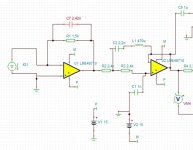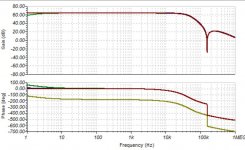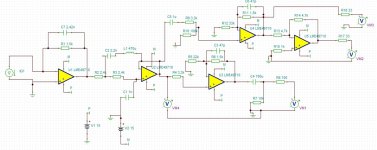Hello all,
I was looking at a DAC circuit recently and discovered a strange type of Sallen-Key filter topology. It looks to me a classic filter, but only with an added series inductor (L1) with the upper capacitor.
So i drew the schematic in TINA and made a simulation. I can see that the filter produces a deep notch at about 160kHz. This is ideal for a DAC running at 176.4kHz in removing the sampling frequency.
Can someone give me the name of this type of filter? I would like to do some more refining and calculation. After looking for 2 days I still didn't found something.
Thanks
I was looking at a DAC circuit recently and discovered a strange type of Sallen-Key filter topology. It looks to me a classic filter, but only with an added series inductor (L1) with the upper capacitor.
So i drew the schematic in TINA and made a simulation. I can see that the filter produces a deep notch at about 160kHz. This is ideal for a DAC running at 176.4kHz in removing the sampling frequency.
Can someone give me the name of this type of filter? I would like to do some more refining and calculation. After looking for 2 days I still didn't found something.
Thanks
Attachments
It's not a Cauer, it's a first order plus notch.
There is a series LC network in the second op amp feedback loop. This network has an impedance minimum at some frequency because at low F the capacitor blocks the signal and at high F the inductor blocks the signal. You can calculate the frequency of a series LC circuit impedance minimum online here:
LC Resonance Calculator
For the values shown, it is 157kHz.
The minimum impedance causes a maximum in the amount of negative feedback around the op-amp amplifier and you get your dip/notch.
The first order LP filter causing the HF rolloff is created by the RC network in the feedback around the first op-amp. It's a separate filter.
There is a series LC network in the second op amp feedback loop. This network has an impedance minimum at some frequency because at low F the capacitor blocks the signal and at high F the inductor blocks the signal. You can calculate the frequency of a series LC circuit impedance minimum online here:
LC Resonance Calculator
For the values shown, it is 157kHz.
The minimum impedance causes a maximum in the amount of negative feedback around the op-amp amplifier and you get your dip/notch.
The first order LP filter causing the HF rolloff is created by the RC network in the feedback around the first op-amp. It's a separate filter.
Thank you Charlie!
I see how it works and know how to calculate it. The general slope is the same as a normal Sallen-Key. The only thing the inductor does is to make a notch at the resonance frequency of the L with the upper capacitor. The value of te upper capacitor is calculated like a normal Sallen-Key!
I see how it works and know how to calculate it. The general slope is the same as a normal Sallen-Key. The only thing the inductor does is to make a notch at the resonance frequency of the L with the upper capacitor. The value of te upper capacitor is calculated like a normal Sallen-Key!
- Status
- Not open for further replies.


